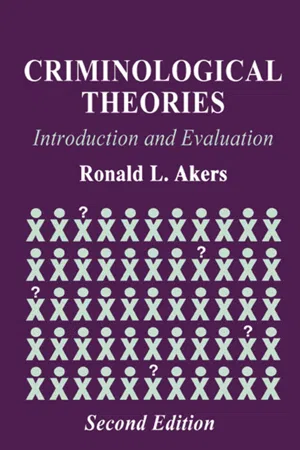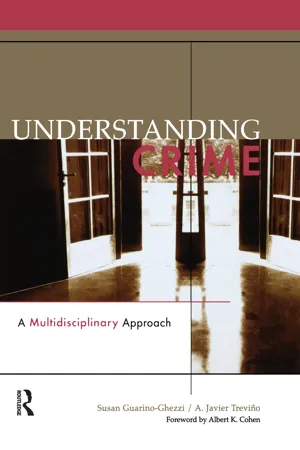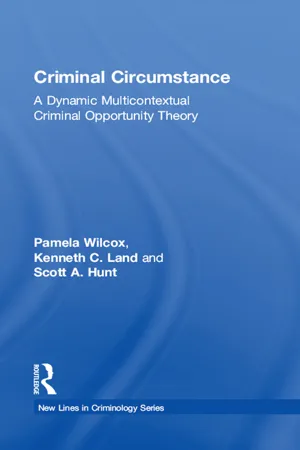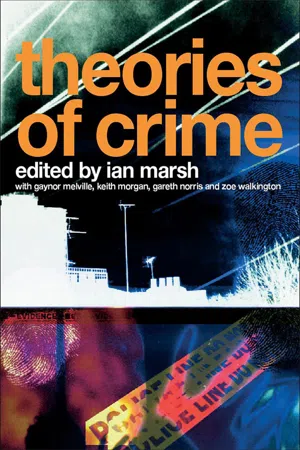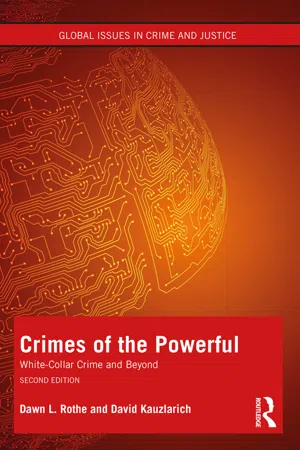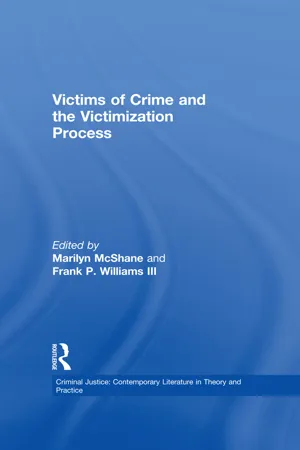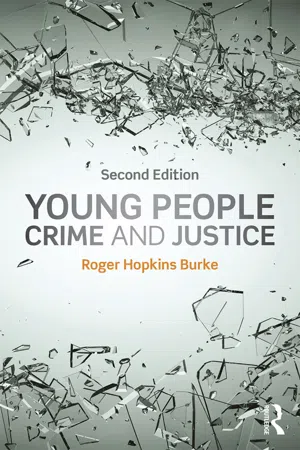Social Sciences
Sociological Theories of Crime
Sociological theories of crime seek to understand the social factors that contribute to criminal behavior. These theories explore how social structures, institutions, and interactions influence individuals' likelihood of engaging in criminal activities. They emphasize the role of socialization, inequality, and power dynamics in shaping criminal behavior within a given society.
Written by Perlego with AI-assistance
Related key terms
8 Key excerpts on "Sociological Theories of Crime"
- eBook - ePub
Criminological Theories
Introduction and Evaluation
- Ronald L. Akers(Author)
- 2013(Publication Date)
- Routledge(Publisher)
(Vold and Bernard, 1986 :4) Theories, then, are really generalizations of a sort; they explain how two or more events are related to each other. (Williams and McShane, 1988:2) A theory is a set of interconnected statements or propositions that explain how two or more events or factors are related to one another. (Curran and Renzetti, 1994 :2) Note that these and other definitions of theory (see Gibbs, 1990) refer to statements about relationships between actual events; about what is and what will be. They are not answers to questions of what ought to be, nor are they philosophical, religious, or metaphysical systems of beliefs and values about crime and society. Criminological theories are abstract, but they entail more than ivorytower or arm-chair speculations. They are part of the broader social science endeavor to explain human behavior and society. Understanding why people conform to or deviate from social and legal norms is an integral part of a liberal education. Moreover, such understanding is vital for those who plan to pursue specialized careers in the law or criminal justice. Virtually every policy or action taken regarding crime is based on some underlying theory or theories of crime. It is essential, therefore, to comprehend and evaluate the major theories of criminology, not only for the academic or research criminologist, but also for the educated citizen and the legal or criminal justice professional. Types of Criminological Theories Edwin H. Sutherland (1947) defined criminology as the study of the entire process of law-making, law-breaking, and law-enforcing. This definition provides us with a starting point for classifying criminological theories. One such major type of theory addresses the first and third part of this process: the making and enforcing of the law. Theories of this kind attempt to account for why we have laws and why the criminal justice system operates the way it does. Another major type of theory explains law-breaking - eBook - ePub
Understanding Crime
A Multidisciplinary Approach
- Susan Guarino-Ghezzi, A. Javier Trevino(Authors)
- 2014(Publication Date)
- Routledge(Publisher)
Durkheim’s “crime as normal” concept and his other ideas about crime and deviance did much to further the development of sociological theorizing about crime. It is to a general discussion of Sociological Theories of Crime that we now turn.Box 2.1 · On the Duty of Civil DisobedienceUnjust laws exist: shall we be content to obey them, or shall we endeavor to amend them, and obey them until we have succeeded, or shall we transgress them at once? . . . If the injustice is part of the necessary friction of the machine of government, let it go, let it go: perchance it will wear smooth—certainly the machine will wear out. If the injustice has a spring, or a pulley, or a rope, or a crank, exclusively for itself, then perhaps you may consider whether the remedy will not be worse than the evil; but if it is of such a nature that it requires you to be the agent of injustice to another, then I say, break the law. Let your life be a counter-friction to stop the machine.Henry David Thoreau, “On the Duty of Civil Disobedience” (1849).Sociological Theories of Crime
In their attempts at understanding crime, sociologists have generally asked, and tried to answer, two basic questions. The first one is: Why do individuals commit crime? And the second, related question is: Why do some communities and certain populations have higher rates of crime than others? Simply put, the broader question is: What are those social factors that cause crime? In order to explain the causes of crime, sociologists have developed theories that examine the factors that produce criminal behavior and high crime rates.A theory is a scientific explanation for a causal relationship between two (or more) measurable phenomena (a change in X causes a change in Y ). For example, an increase in poverty leads to an increase in crime. Theorists might first observe an increase in the poverty rate that is followed by an increase in the crime rate. Then the theorist would develop an explanation demonstrating the sociological connections between poverty and crime to rule out the possibility that the poverty-crime correlation is merely a coincidence. Any phenomenon that can be measured is called a variable. A variable - eBook - ePub
Criminal Circumstance
A Dynamic Multi-Contextual Criminal Opportunity Theory
- Kenneth Land(Author)
- 2018(Publication Date)
- Routledge(Publisher)
Thus far we have provided a general overview of the importance, nature, and assessment of theory. We now outline the basic contours of our multicontextual criminal opportunity theory. A brief explication of criminal acts begins this discussion. We then provide an overview of the fundamental logic and conceptual framework underlying our multicontextual criminal opportunity perspective.On the surface, it seems rather obvious what a criminological theory seeks to explain: crime. However, any serious attempt to specify what is to be explained in a precise, scientific manner exposes a tangled web of conceptual problems. If “crime” refers to any violation against the law, then a theory that purports to explain it would include such diverse acts as double parking and premeditated murder. Limiting “crime” to violations of the law would mean that the very same act (e.g., marital rape) could be classified as both criminal and not criminal in two different cultural, geopolitical contexts. Likewise, the very same act (e.g., smoking marijuana) could be classified as both criminal and not criminal in two different historical moments in the same cultural, geopolitical context. Gottfredson and Hirschi consider how this problem is typically identified and “addressed” by modern criminologists:Criminologists often complain that they do not control their own dependent variable, that the definition of crime is decided by political-legal acts rather than by scientific procedures. The state, not the scientist, determines the nature or definition of crime. After registering this complaint, the modern criminologist proceeds to define crime as “behavior in violation of the law” and to study the phenomenon as defined by others. (1990:3) - eBook - ePub
- Ian Marsh(Author)
- 2007(Publication Date)
- Routledge(Publisher)
Sutherland argued that crime was socially defined by powerful sections of society, but he did not lose sight of the individual and how particular individuals were drawn into crime. He felt that criminal behaviour was learned just as any form of behaviour is. This led to the question of how is criminal behaviour learned, which Sutherland answered in terms of differential association: individuals have differential associations with other people who are either more or less disposed to criminality. The essence of this approach is that criminal behaviour is learned; the learning occurs through association with other people; learning includes ways and means for carrying out crimes; and so the process involved in learning criminal behaviour is no different from that involved in learning any other type of behaviour. It can be seen from this brief account that Sutherland’s theory is both sociological, in its acknowledgement of the powerful of social forces to define crime, and psychological, with its concern for the individual. And, as with Matza’s work, Sutherland applied his theory of differential association to business crime or crimes of the powerful.This emphasis on interactions indicates the influence of the notion of differential association on the labelling explanations that developed from the interactionist (sometimes known as symbolic interactionist) perspective within sociology.INTERACTIONIST THEORIES
Partly in response to some of the problems associated with the structural and subcultural theories, a different theoretical approach was developed by the interactionist perspective that became particularly influential in sociology in the 1960s and 1970s. Rather than seeing crime and deviant behaviour as a response of people to their social situation—and a response which established them as distinct from the mainstream, ‘normal’ population—the interactionist position was that the criminal or deviant can be quite normal. The emphasis, therefore, should be on how society defines certain individuals and groups as criminal or deviant. As can be seen from this introductory paragraph, interactionists refer to both crime and deviance, and the terms are quite often used interchangeably. Essentially, crime can be defined as action that breaks the criminal law and can be followed by criminal proceedings, while deviance is not used in its literal sense (as anything that is different or deviates from the normal) but taken to refer to any behaviour that is outside the rules of society and that is generally disapproved of. These rules might be legal rules, such as laws, or social and moral rules, such as conventional rules about how people should behave in public, for instance. Below we will usually refer to crime and criminal behaviour when introducing labelling theory. - eBook - ePub
Crimes of the Powerful
White-Collar Crime and Beyond
- Dawn Rothe, David Kauzlarich(Authors)
- 2022(Publication Date)
- Routledge(Publisher)
Chapter 3 Theoretical Understandings of Crimes of the PowerfulDOI: 10.4324/9781003124603-3We should state at the onset that our approach here is not like most textbooks on white-collar crime that introduce you to a host of criminological theories you read small snippets of and attempt to apply (e.g., biosocial theories, psychological theories, social control, rational choice, low self-control models, or even social bond models). Although many traditional criminological theories contribute to some understanding of juvenile delinquency, robbery, burglary, and other conventional domestic criminal activities, as individual theories, they have serious shortcomings and are only able to explain a small portion of variance (Agnew 2012; Kauzlarich and Barlow 2009). This has resulted in limited understanding and a general over-focus on individuality and subsequent individual “blame.” Of course, personality, socialization, and upbringing do matter to a small degree. We have all most likely met a narcissistic, self-aggrandizing, or hedonistic person. Yet, many of these theoretical perspectives result in simplistic interpretations where motivations are reduced to “greed,” “psychopathic traits,” or socialization. Additionally, many of these theories need a well-rounded base of personal individual facts, from life background to mental health conditions, that are generally unavailable to researchers and/or omitted from any analysis.Instead, we aim to take a much broader approach given that our underlying assumption is that crimes of the powerful are not parsimonious events, acontextual or ahistorical, but are complex phenomena that must account for a broad array of conditions including individual agency. Humans and the human mind are complex, and individuals do not operate in a vacuum. This is especially true for the powerful criminal, whose actions, motivations, and responses are situated within a system that fosters and facilitates their crimes and should not be ignored or discounted. - eBook - ePub
- McShane(Author)
- 2013(Publication Date)
- Routledge(Publisher)
As a way of overcoming compartmentalized thinking, the integration of theories of criminality and victimization should improve substantially our understanding of crime. From their inception, theories of criminality (e.g., strain, social disorganization, differential association, social bond) have emphasized the structural and social psychological factors associated with criminal motivation, but they have ignored how the actions of potential crime targets condition the physical opportunities for victimization. The primary goal of these theories has been to explain the decision to engage in crime. In contrast, theories of victimization emphasize the causal role of personal characteristics that enhance the accessibility and attractiveness of crime victims, but these theories largely neglect sources of criminal motivation. By addressing both crime-commission and target-selection decisions, it is easier to see the value of an integrated perspective.From an integrated perspective, crime is not simply what offenders do and what victims do. Rather, understanding crime from an integrated perspective requires an understanding of the social structure that surrounds both criminals and victims. It is that structure, or context, that creates both offender motivation and victim risk-taking. Integrated theories are theories sensitive to the nature and impact of that structure. Such theories are informed about offenders, victims, and structural facilitators that link them. Furthermore, such theories, if they are to be truly useful, will be testable and judged on their predictive validity. Traditional “isolationist” approaches that focus only on one component of the larger picture are necessarily limited and should be tolerated only insofar as they contribute to larger theoretical structures. Both more sophisticated offender and victim theories can make such a contribution.VIII. ConclusionsCurrent theories of victimization highlight the symbiotic relationship between conventional and illegal activities. Regardless of their particular terminology, routine activities and lifestyle-exposure theories emphasize how criminal opportunities develop out of the routine activities of everyday life. Routine activity patterns that increase proximity to motivated offenders, increase exposure to risky and dangerous situations, enhance the expected utility or attractiveness of potential crime targets, and reduce the level of guardianship are assumed to increase aggregate rates and individuals’ risks of predatory crime. These criminal opportunity theories have been used to account for changes in crime rates in the United States over time, the level of crime in aggregate units (e.g., cities, SMSAs), differences in victimization risks for different social groups (e.g., males, single persons, younger people), and individuals’ risks of victimization. - eBook - ePub
Deviance and Crime
Theory, Research and Policy
- Walter S. DeKeseredy, Desmond Ellis, Shahid Alvi(Authors)
- 2014(Publication Date)
- Routledge(Publisher)
Third, while the metaphor of multi-player games such as ice hockey, football, or baseball may be applied to symbolic interaction and society, Mead’s game has one very important and distinctive property: in the course of interacting with each other, self-images and the rules of the game may be changed. New self-images and rules may be created, some rules applied, and other’s not. Simply examining the game’s rules as they appear in the rule book will not tell you very much about how the game is actually played or about the course of the game. Games like ice hockey have an emergent quality to them, and the process of emergence must be studied directly. The game’s structure, its rules, and its competitive values should be taken into account, but the primary focus of analysis is the process of symbolic interaction. The large, many-player game called society emerges out of, and can be changed by, the symbolic interaction that takes place among individuals in such small-scale settings as homes, schools, workplaces, churches, and so on.Most sociologists who adopt a social psychological, symbolic interactionist approach to the study of deviant and/or criminal social behavior in these settings work with a set of sensitizing concepts bequeathed them by Mead. These include interaction, symbols, meanings, process, emergence, and self-concept. A few have borrowed concepts formulated by other theorists, and some have tried to combine Mead’s micro-sociological approach with a macro-sociological one.In Chapter 1 , we briefly described one type of interactionist theory that has been applied to the study of crime and deviance: the societal reaction/labeling perspective. There, we said that societal reaction/labeling theorists want to develop a sociological understanding of how people and behaviors come to be designated as criminal or deviant. This is very different from wanting to describe the causes of crime. Recall that for scholars such as Howard Becker (1973), nothing is inherently deviant or criminal. Rather, crime is a social construct or a label attached to a behavior during the course of social interaction between rule-makers and rule-breakers. Here, we introduce you to one major variant of the interactionist perspective: Sutherland’s differential association theory.Differential Association Theory
As originally formulated by Sutherland (1947) and later revised by Sutherland and Cressey (1966), differential association theory is an interactionist account of both conformity and deviation. However, because of its inclusion of motives, its emphasis on the original or random causes of deviance/crime, and its acceptance of the traditional notion that social control is caused by deviance instead of vise versa, differential association theory differs from the interactionist accounts reviewed in Chapter 1 - eBook - ePub
- Roger Hopkins Burke(Author)
- 2016(Publication Date)
- Routledge(Publisher)
People will always want and seek further economic reward and it is not therefore necessary to seek motives for engaging in criminal activity. Human beings are born free to break the law and will only refrain from doing so under particular circumstances, and it is these fundamental rational actor model assumptions that provide the foundations of the later influential social control theories. Criminological theories, under whatever guise, usually view conformity to be the natural state of humanity; in other words, criminal behaviour is simply abnormal and it is this orthodox way of thinking about crime that social control theory seeks to challenge. Thus, the central question asked from this perspective is not the usual, ‘why do some people commit crimes?’ but rather, ‘why do most of us conform?’ The unifying factor in the different versions of control theory is the assumption that crime and deviance are only to be expected when social and personal controls are in some way inadequate and fail to restrain the individual from criminal involvement. Early control theories attached much importance to psychological factors. Reiss (1951) distinguished between the effects of ‘personal’ and ‘social’ controls, proposing that the former arise when individuals internalise the norms and rules of non-deviant primary groups to such an extent that they become their own; the latter are founded in the ability of external social groups or institutions to make rules or norms effective. Conformity involves simple acquiescence and does not require the internalisation of rules and norms within the value system of the individual
Learn about this page
Index pages curate the most relevant extracts from our library of academic textbooks. They’ve been created using an in-house natural language model (NLM), each adding context and meaning to key research topics.
